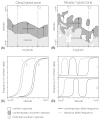Hybrid zones: windows on climate change
- PMID: 25982153
- PMCID: PMC4794265
- DOI: 10.1016/j.tree.2015.04.010
Hybrid zones: windows on climate change
Abstract
Defining the impacts of anthropogenic climate change on biodiversity and species distributions is currently a high priority. Niche models focus primarily on predicted changes in abiotic factors; however, species interactions and adaptive evolution will impact the ability of species to persist in the face of changing climate. Our review focuses on the use of hybrid zones to monitor responses of species to contemporary climate change. Monitoring hybrid zones provides insight into how range boundaries shift in response to climate change by illuminating the combined effects of species interactions and physiological sensitivity. At the same time, the semipermeable nature of species boundaries allows us to document adaptive introgression of alleles associated with response to climate change.
Keywords: adaptive introgression; distribution; gene flow; hybridization; range limits.
Copyright © 2015 Elsevier Ltd. All rights reserved.
Figures



References
-
- Rosenzweig C, et al. Attributing physical and biological impacts to anthropogenic climate change. Nature. 2008;453:353–357. - PubMed
-
- Lavergne S, et al. Biodiversity and climate change: integrating evolutionary and ecological responses of species and communities. Ann Rev Ecol Evol Syst. 2010;41:321–350.
-
- Quintero I, Wiens JJ. Rates of projected climate change dramatically exceed past rates of climatic niche evolution among vertebrate species. Ecol Lett. 2013;16:1095–1103. - PubMed
-
- Norberg J, et al. Eco-evolutionary responses of biodiversity to climate change. Nature Clim Change. 2012;2:747–751.
Publication types
MeSH terms
Grants and funding
LinkOut - more resources
Full Text Sources
Other Literature Sources
Medical

